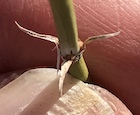Conservation Status

Ephedra californica
S. Watson 1879
Common names
California jointfir (Jaeger 1969), California ephedra, cañatillo (Stevenson 1993).
Taxonomic notes
Description
"Shrubs erect, 0.25-1 m. Bark gray-brown, cracked and irregularly fissured. Branches alternate or whorled, semiflexible to rigid, angle of divergence about 45°. Twigs yellow-green, becoming yellow, then yellow-brown with age, glaucous, with numerous very fine longitudinal grooves; internodes 3-10 cm. Terminal buds conic, 2-3 mm, apex acute. Leaves in whorls of 3, 2-6 mm, connate to 1/2-3/4 their length; bases at first membranous, then becoming thickened, completely deciduous; apex acute. Pollen cones 1-several at node, ovoid, 6-8 mm, on short, scaly peduncles; bracts in 8-12 whorls of 3, light orange-yellow, ovate, 2-3 × 2-3 mm, membranous, slightly united at base; bracteoles equaling or slightly exceeding bracts; sporangiophores 3-5 mm, exserted to 1/3 their length, with 3-7 sessile to short-stalked microsporangia. Seed cones 1-several at node, ovoid, 8-10 mm, on very short, scaly peduncles; bracts in 4-6 whorls of 3, circular, 5-7 × 5-10 mm, papery, with orange- to green-yellow center and base, slightly clawed, margins entire. Seeds 1(-2), nearly globose, 7-10 mm diam., brown, smooth. ... Coning March-April" (Stevenson 1993).
Stevenson (1993) provides this Key to the North American species of Ephedra.
Distribution and Ecology
US: California and Mexico: Baja California Norte, in the Mojave and Colorado deserts at 50-1000 m on valleys and bajadas (Jaeger 1969, Stevenson 1993).
Remarkable Specimens
No data as of 2023.03.03.
Ethnobotany
Observations
Remarks
The epithet refers to the species' occurrence in California.
I sampled one and it has growth rings. Whether they are annual rings remains to be determined.
Citations
Watson, Sereno. 1879. Contributions to American botany. II. Descriptions of some new species of North American plants. Proceedings of the American Academy of Arts and Sciences 14:288-303 (p. 300).
See also
Species profile at Plants of the World Online, accessed 2021.12.29.



